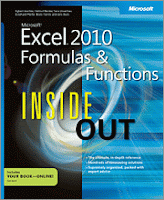
In the first section a problem solving approach offers a speedy orientation to some of Excel's most useful formulas and functions. The many insights, tips and tricks also whet the appetite for what's to come.
The second section lifts functions out from the worksheet cells, and spotlights how they can be used within macros to deliver more sophisticated programming solutions. It's a good place to discover new concepts and ideas. Many of these solutions also include visual and charting scenarios, plus there's an introduction to creating custom functions with Excel's built-in Visual Basic for Applications (VBA) development tools.
In both these sections the content is attractively presented in a practical step-by-step flow. Most pages have at least one colourful image, figure or table. The text is further supplemented by plenty of embedded boxes containing notes, tips, associated information and references to sample files. It's a presentation style that lends itself to the experimental approach, rather than a long reading session.
Although not strictly in the formula and function domain, the authors have also thrown in examples of the new PowerPivot in action. A feature I'm sure will be heavily utilised by 2010 edition owners.
Section three is dedicated to in-depth function explanations, suitably organised into category-specific chapters. Despite the technical nature of the content, even here there's no shortage of colourful graphics and informative boxes.
And finally, the appendixes contain the obligatory function lists in A-Z and category arranged format, plus a summary of the features new to Excel 2010.
The comprehensive nature of this reference is further enhanced by a suitably large collection of downloadable sample files. These samples are fully cross referenced by chapter usage at the front of the book.
In conclusion this book is a strong product in this competitive marketplace. It's certainly a book I could recommend to anyone with a basic understanding of Excel and a desire to dig deeper into its potential. And despite being aimed at Excel 2010, there's still a great deal of value for 2003 and 2007 version users.
